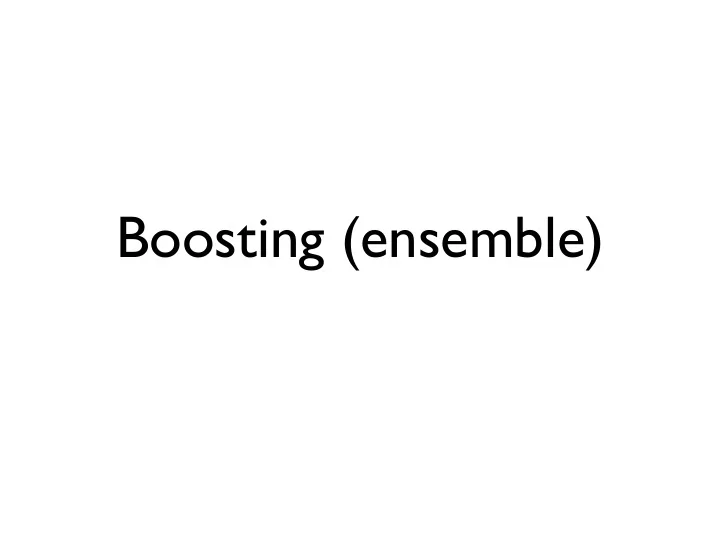

Boosting (ensemble)
Module 4 - Ensemble classifiers - Objectives module 4: boosting (ensemble models) LEARNING PERFORMANCE REPRESENTATION DATA PROBLEM RAW DATA CLUSTERING EVALUATION FEATURES UCI datasets unigrams 20newsgroups SUPERVISED ANALYSIS SELECTION LEARNING LABELS boost/adaboost multiclass TUNING gradient boosting ECOC DIMENSIONS active learning DATA ECOC setup PROCESSING • BOOSTING: combine weak/simple classifiers into a powerful one • Bagging: combine classifiers by sampling training set • Active Learning: select the datapoints to train on • ECOC for Multiclass data : introducing the 20Newsgroups dataset of articles • VC dimension as a measure of classifier complexity
Weak Learners • Need not to be very accurate • Better than random guess • Examples: - Decision trees/Decision stump - Neural Network - Logistic regression - SVM - Essentially any classifier
Decision Stump • 1-Level decision tree • A simple test based on one feature • Eg: If an email contains the word "money", it is a spam; otherwise, it is a non-spam • moderately accurate • Geometry: horizontal or vertical lines Positive Positive e v i t Negative a g e N
Limitation of Weak Learner • Might not be able to fit the training data well (high bias) • Example: no single decision stump can classifier all the data points correctly � � �
Can weak learners combine to do better? • Can we separate the positive data from the negative data by drawing several lines? • Yes, we can!
Can weak learners combine to do better? • It turns out this complicated classifier can be expressed as a linear combination of several decision stumps
An analogy of Committee • A weak Learner = a committee member • Combination of weak leaners(ensemble) = a committee • A Weak learner's decision hypothesis = a committee member's judgement • Ensemble's decision hypothesis = a committee's decision • A combination of weak learners often classifies better than a single weak learner = a committee often makes better decisions than a single committee member
Idea : Generating diverse weak leaners • adaBoost picks its weak learners h in such a fashion that each newly added weak learner is able to infer something new about the data • adaBoost maintains a weight distribution D among all data points. Each data point is assigned a weight D(i) indicting its importance • by manipulating the weight distribution, we can guide the weak learner to pay attention to different part of the data
Idea : Generating diverse weak leaners • AdaBoost proceeds by rounds • in each round, we ask the weak learner to focus on hard data points that previous weak learners cannot handle well � • Technically, in each round, we increase the weights of misclassified data points, and decrease the weights of correctly classified data points
• AdaBoost init: uniform weight distribution D on datapoints • AdaBoost loop: - train weak learner h according to current weights D � - observe error(h,D); compute coefficient - � - store weak learner h t , coefficient 𝜷 t � - update Distribution D for next round, emphasizing misclassified points • AdaBoost final classifier •
Adaboost Algorithm
Adaboost Algorithm init setup
Adaboost Algorithm init setup round error
Adaboost Algorithm init setup round error weight update
Adaboost Algorithm init setup round error weight update final classifier
Adaboost : an example
Adaboost : an example
Adaboost : an example
Adaboost : an example
Adaboost Training error
Adaboost Training error
Adaboost Training error • comments: ¡in ¡practice, ¡we ¡usually ¡stop ¡ boosting ¡after ¡certain ¡iterations ¡to ¡both ¡ save ¡time ¡and ¡prevent ¡overfitting
Adaboost Training error
Adaboost Training error
Boosting and Margin Distribution
Adaboost testing error based on VC dim • d = VC dim of classifiers (measure of complexity) • T = number of boosting rounds - a loose bound as T can be very large, without decreasing the testing error
Adaboost testing error based on margins • A better bound for testing error based on margins • Does not depend on T= number of boosting rounds
Deep decision trees vs Boosted decision stumps • Deep decision trees and Boosted decision stumps look very similar. Both can easily drive the training error down to 0, and both yield similar decision boundaries. Why does boosted decision stumps often generalize better than deep decision trees? Boosted decision Deep Decision Tree stumps Partition the lines parallel to axis lines parallel to axis space Decision zig-zags zig-zags boundary Bias low low
Deep decision trees vs Boosted decision stumps Deep Decision Tree Boosted decision stumps Variance high low Each leaf node contains at least one example. The number of examples required Can generalize to regions not covered by to train a constant-leaves decision Representation the training set. Have exponentially more tree can grow exponentially with the Power efficient power than single decision trees. dimension of the input space. Cannot generalize to new variations. � voting on local tiny regions among voting among weak learners. If learners voting schema data points; more likely to overfit have low complexity, harder to overfit.
Bagging Decision Trees • Train multiple classifiers, independently � • Each classifier = Decision Tree trained on a sampled-with-replacement dataset � • Final prediction: run all classifiers, average their output
Bagging : sampling with replacement • Trainset of size N; want sampling set of size N � • For i=1:N - Randomly select a point Xi from Trainset - Do not remove this point so it can be sampled again � • Not all points will be selected - selected points expected count ~63%*N • Some points all be selected multiple times
Bagging Decision Trees VS Boosting • Both have final prediction as a linear combination of classifiers � • Bagging combination weights are uniform; boosting weights ( 𝜷 t ) are a measure of performance for classifier at round � • Bagging has independent classifiers, boosting ones are dependent of each other � • Bagging randomly selects training sets; boosting focuses on most difficult points
Recommend
More recommend